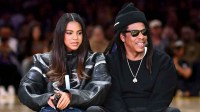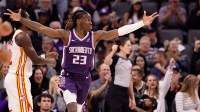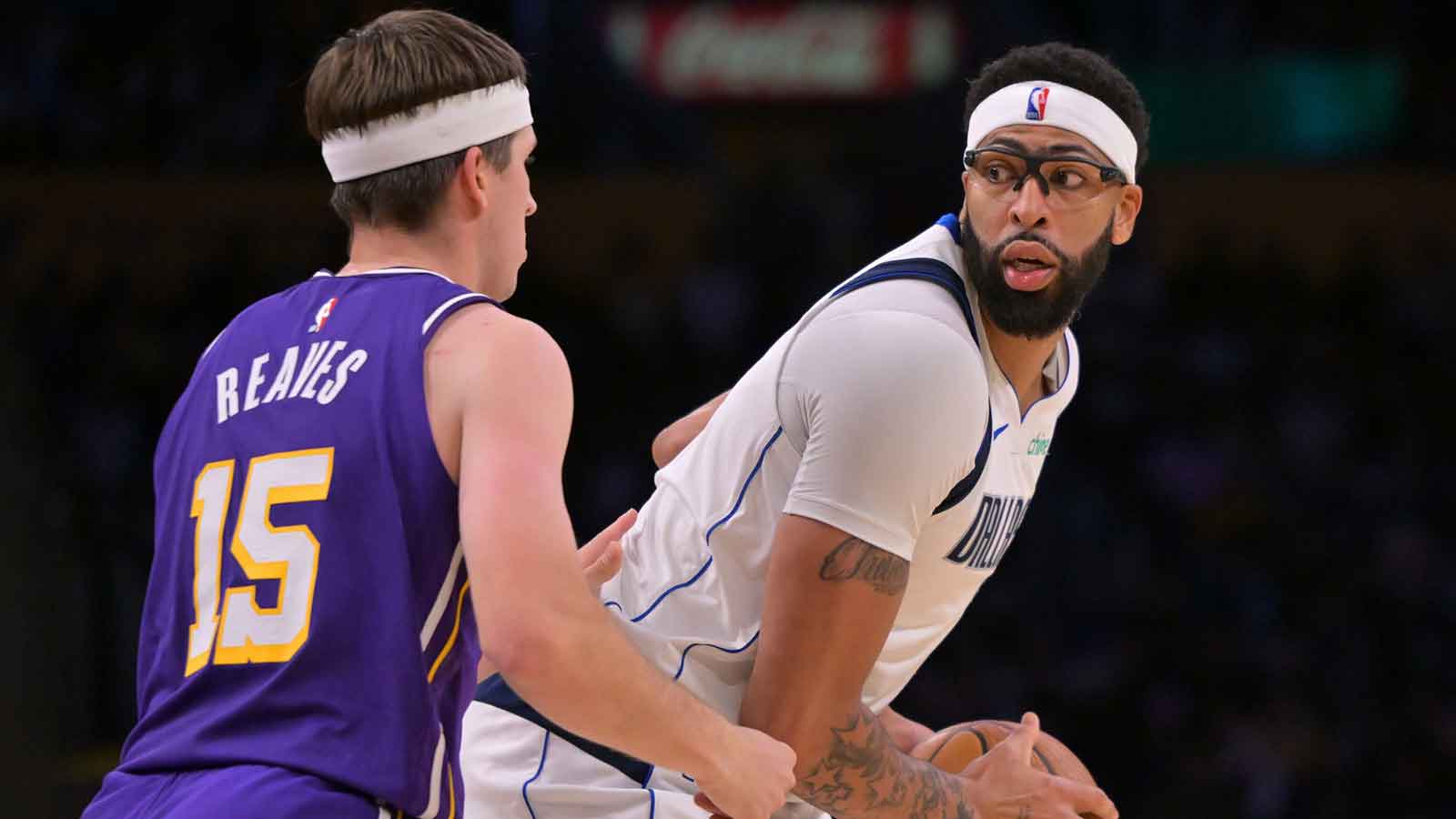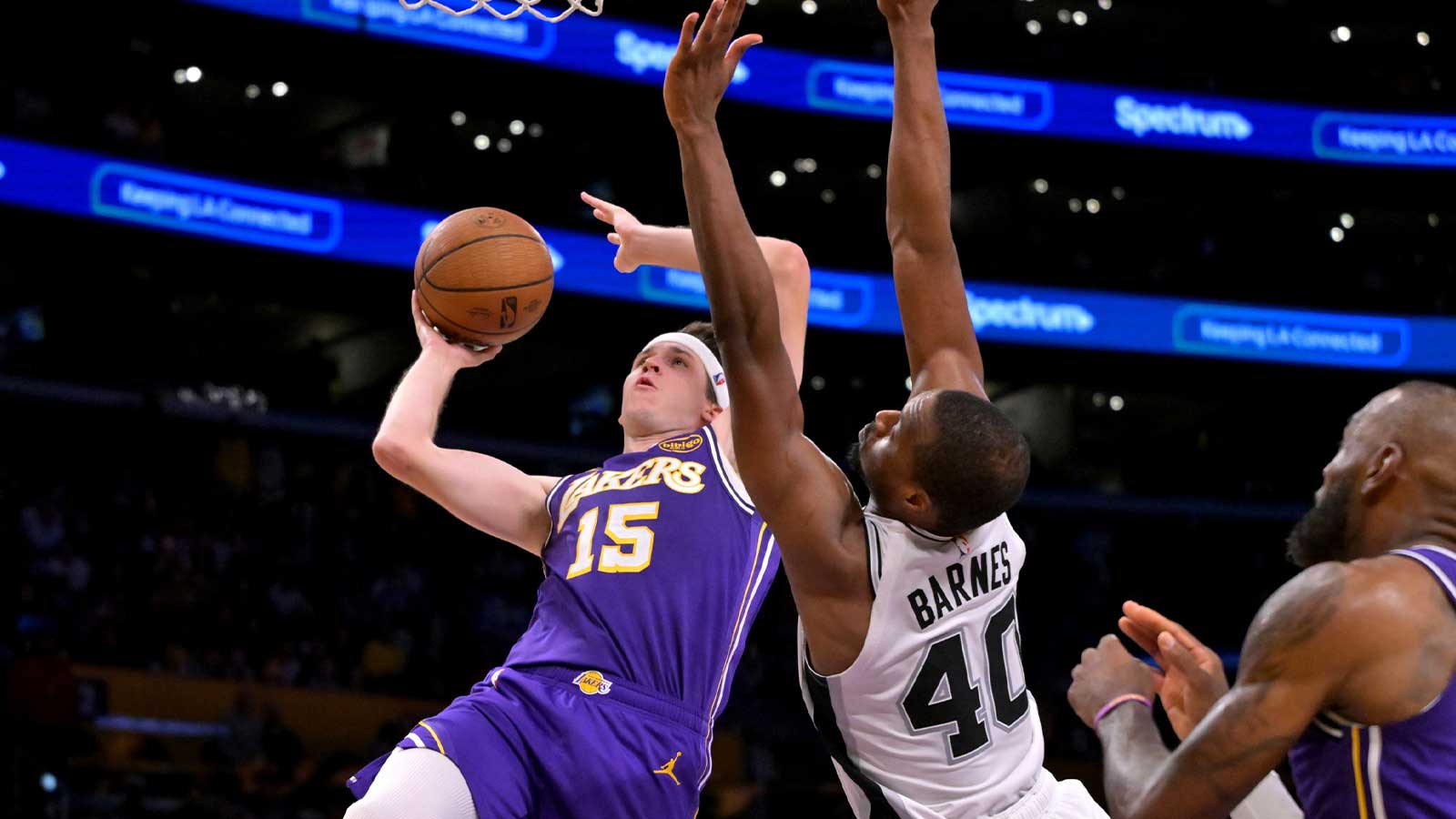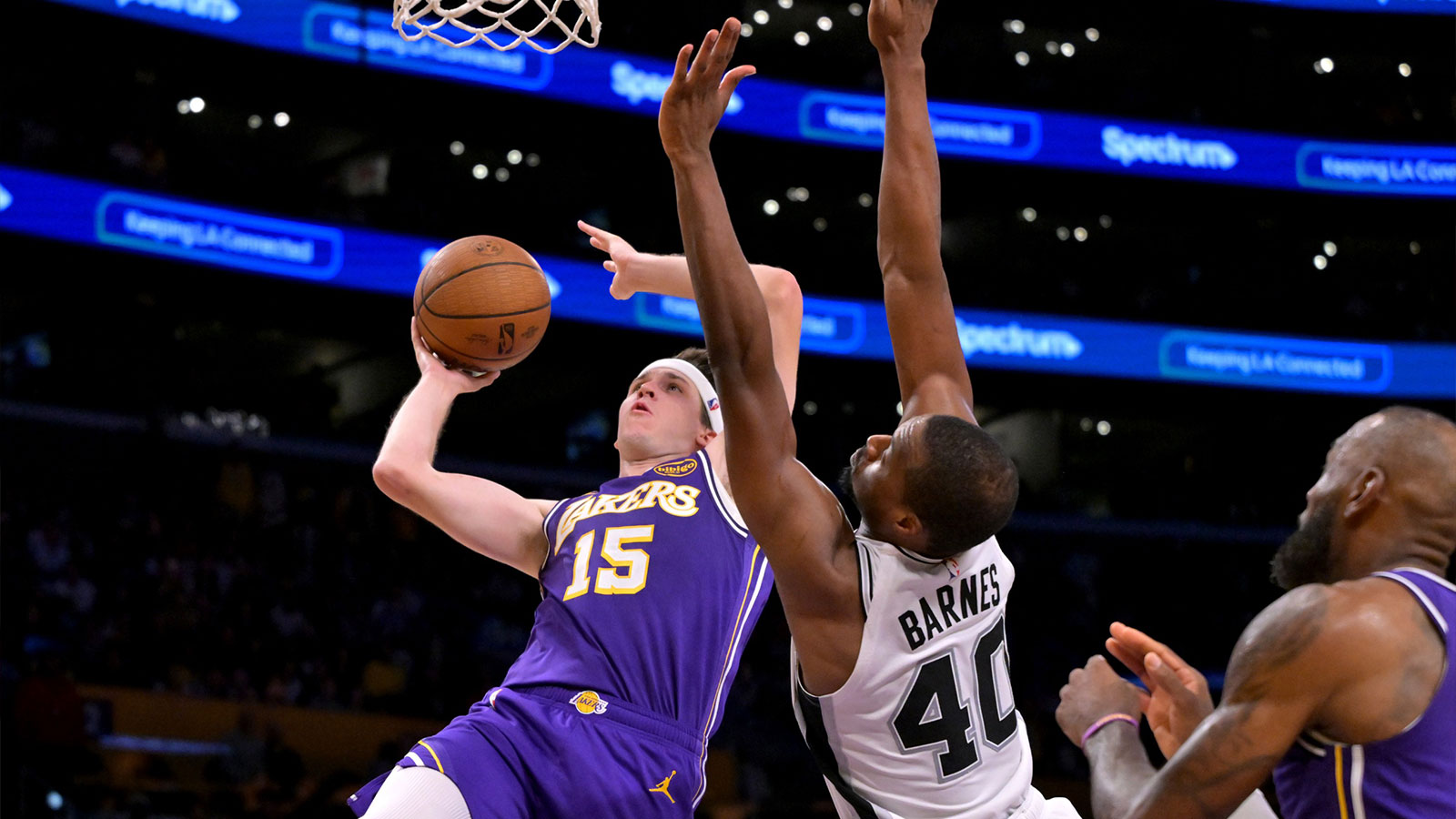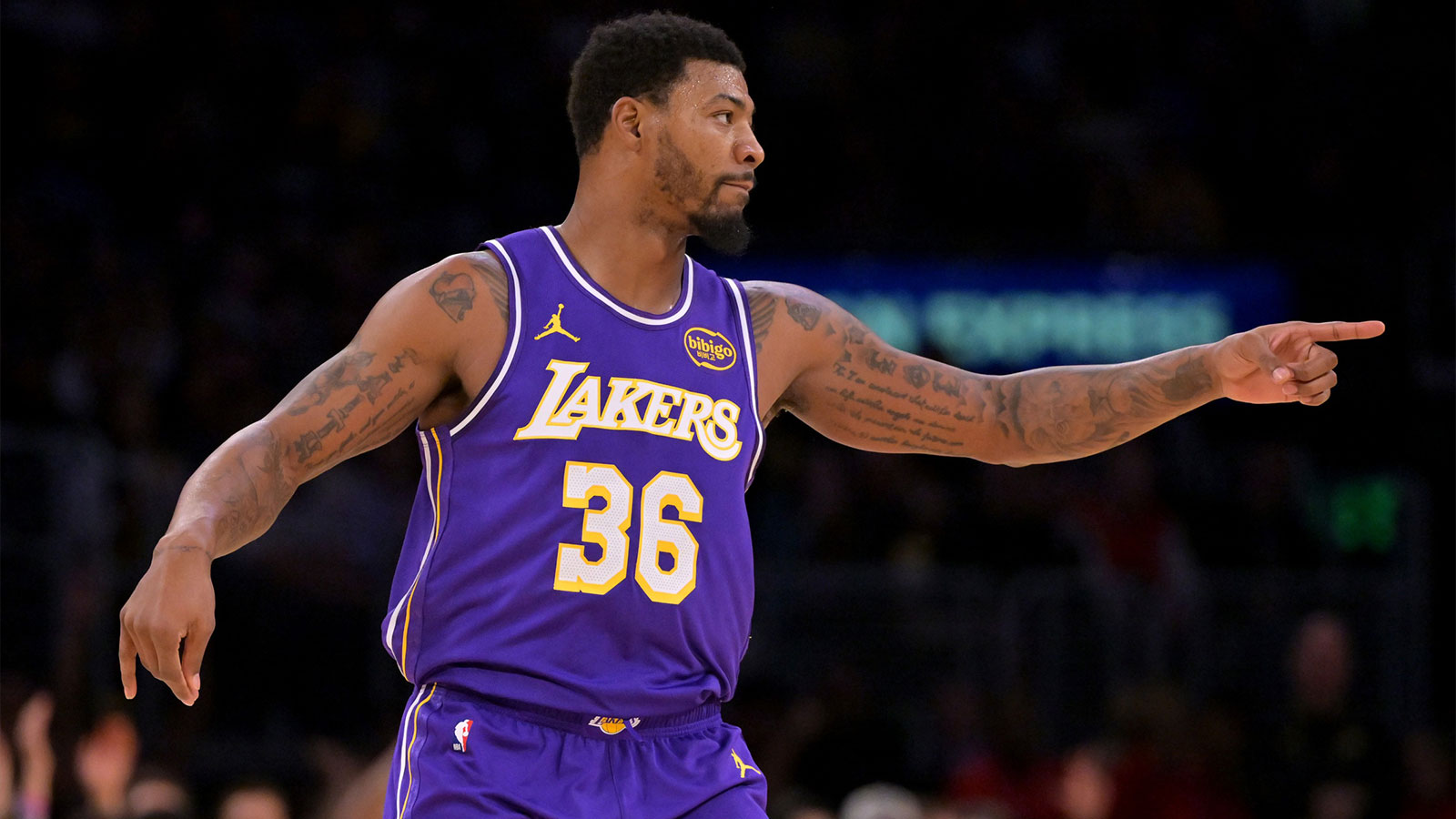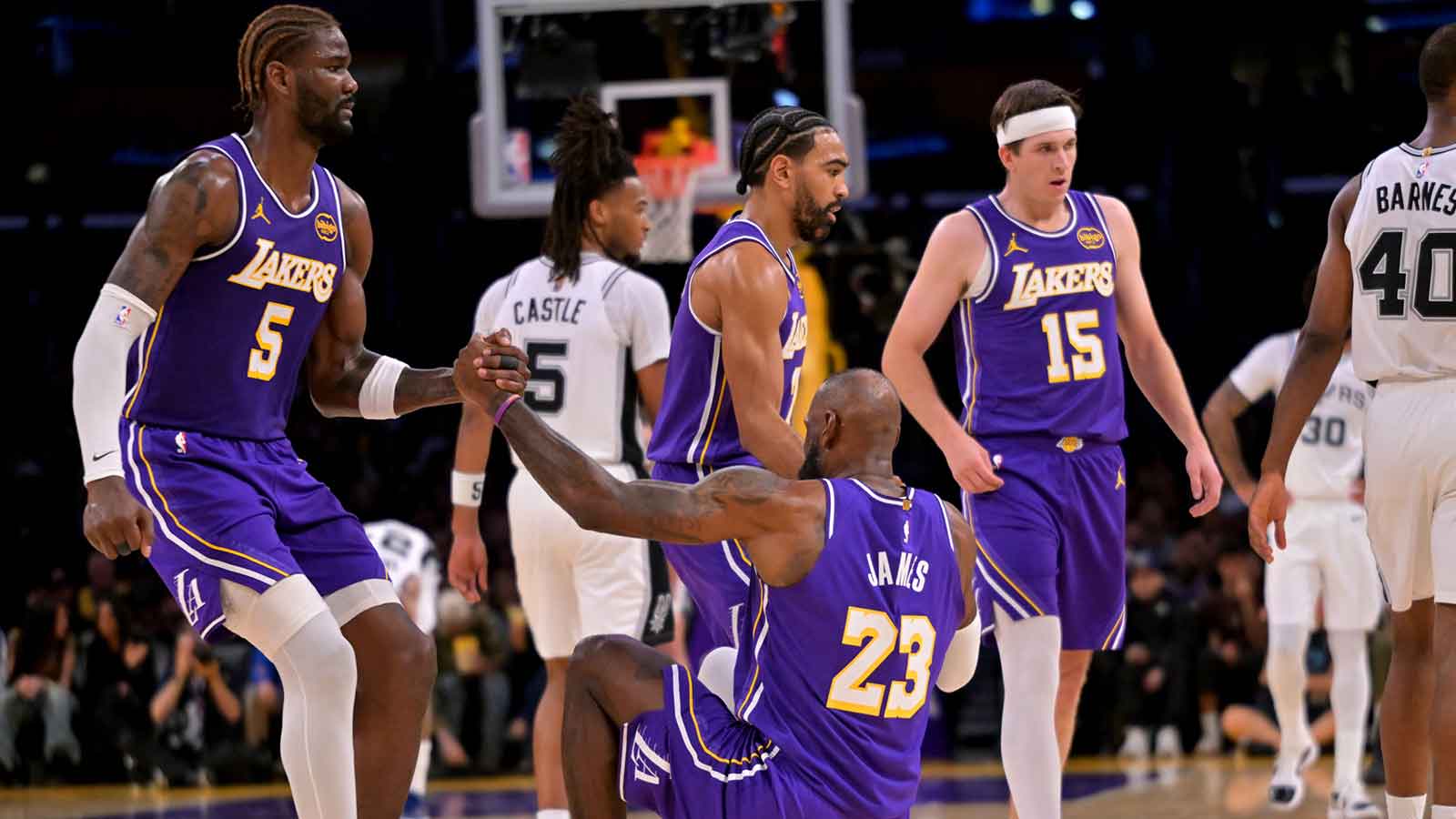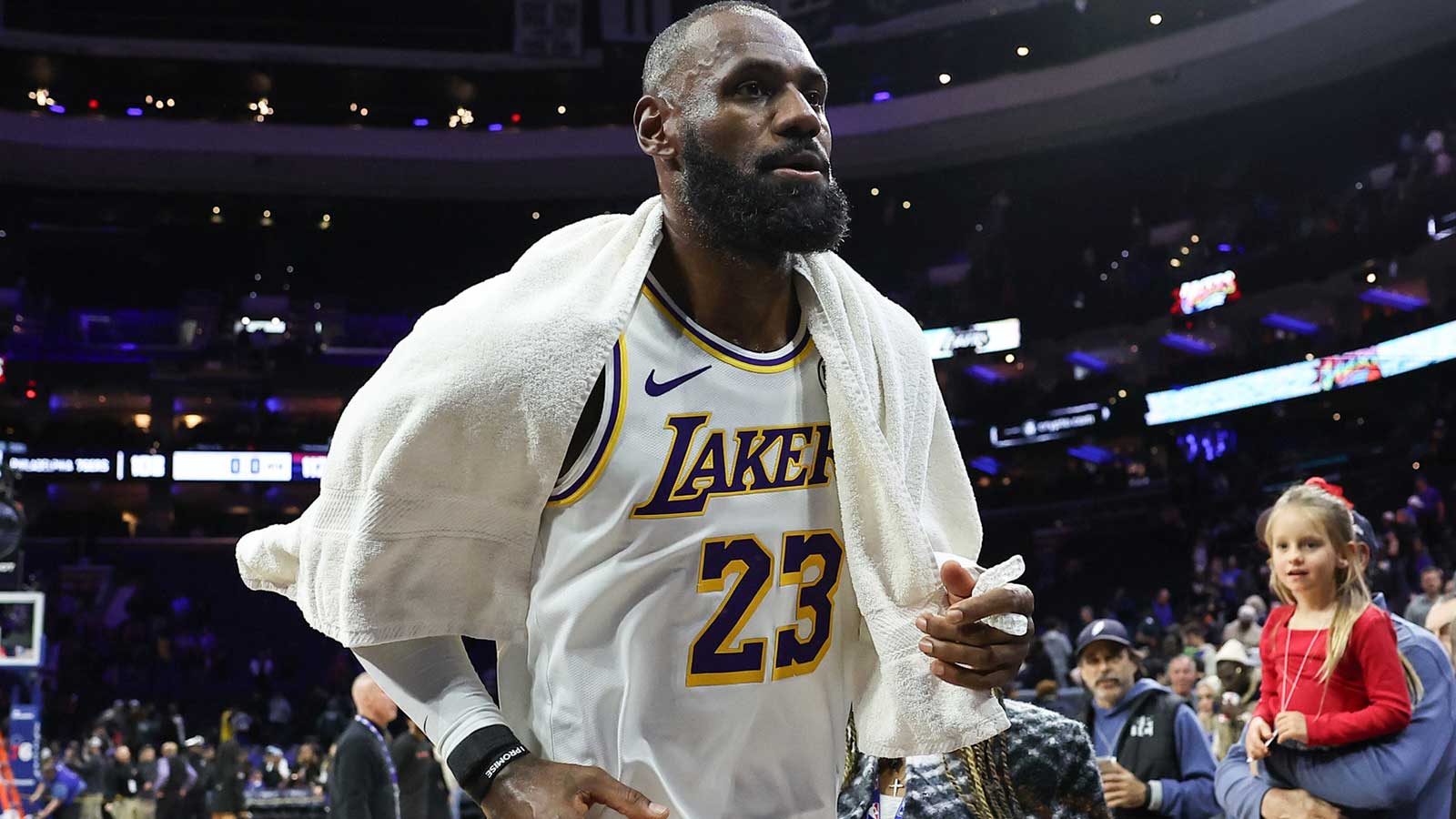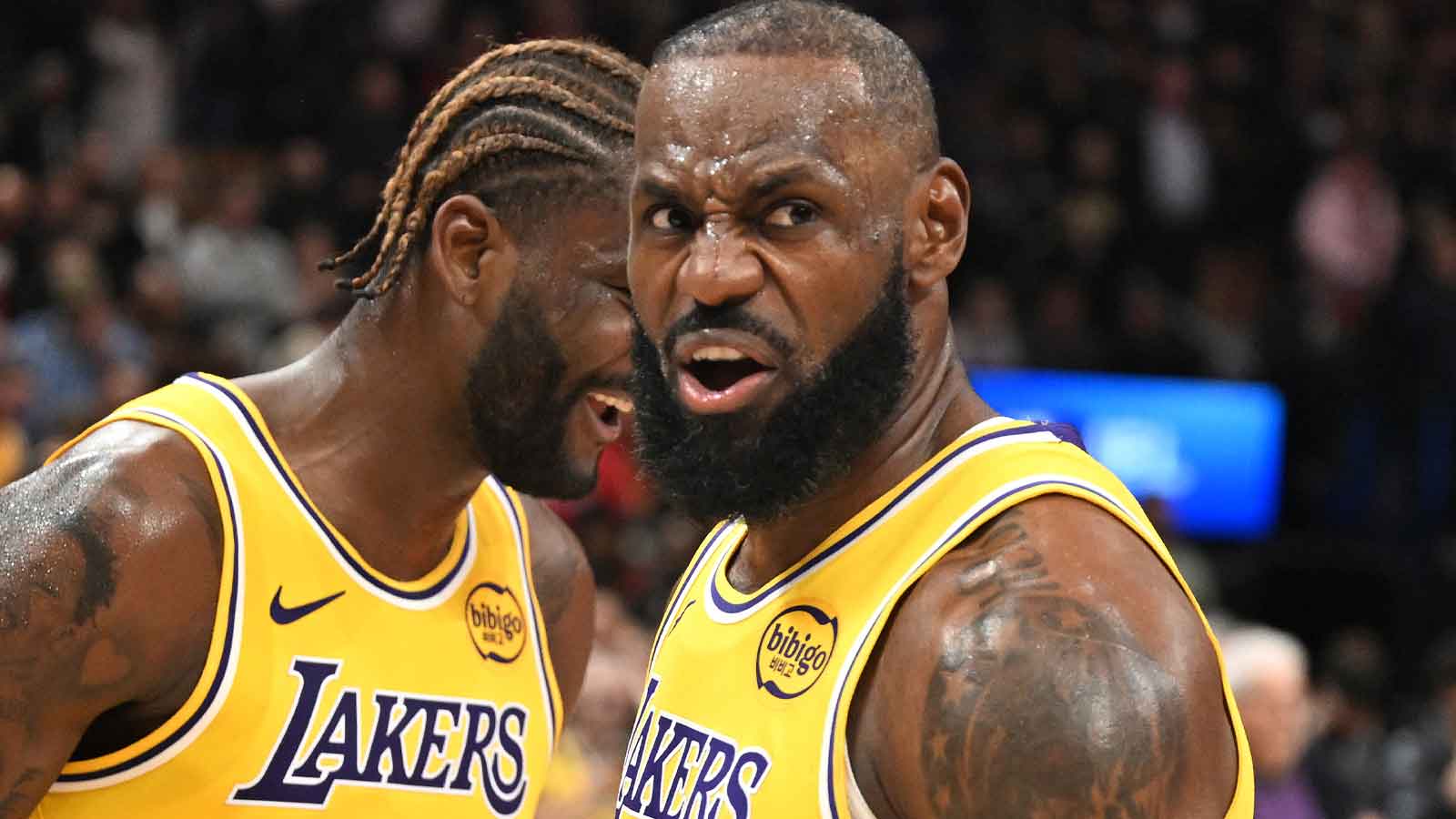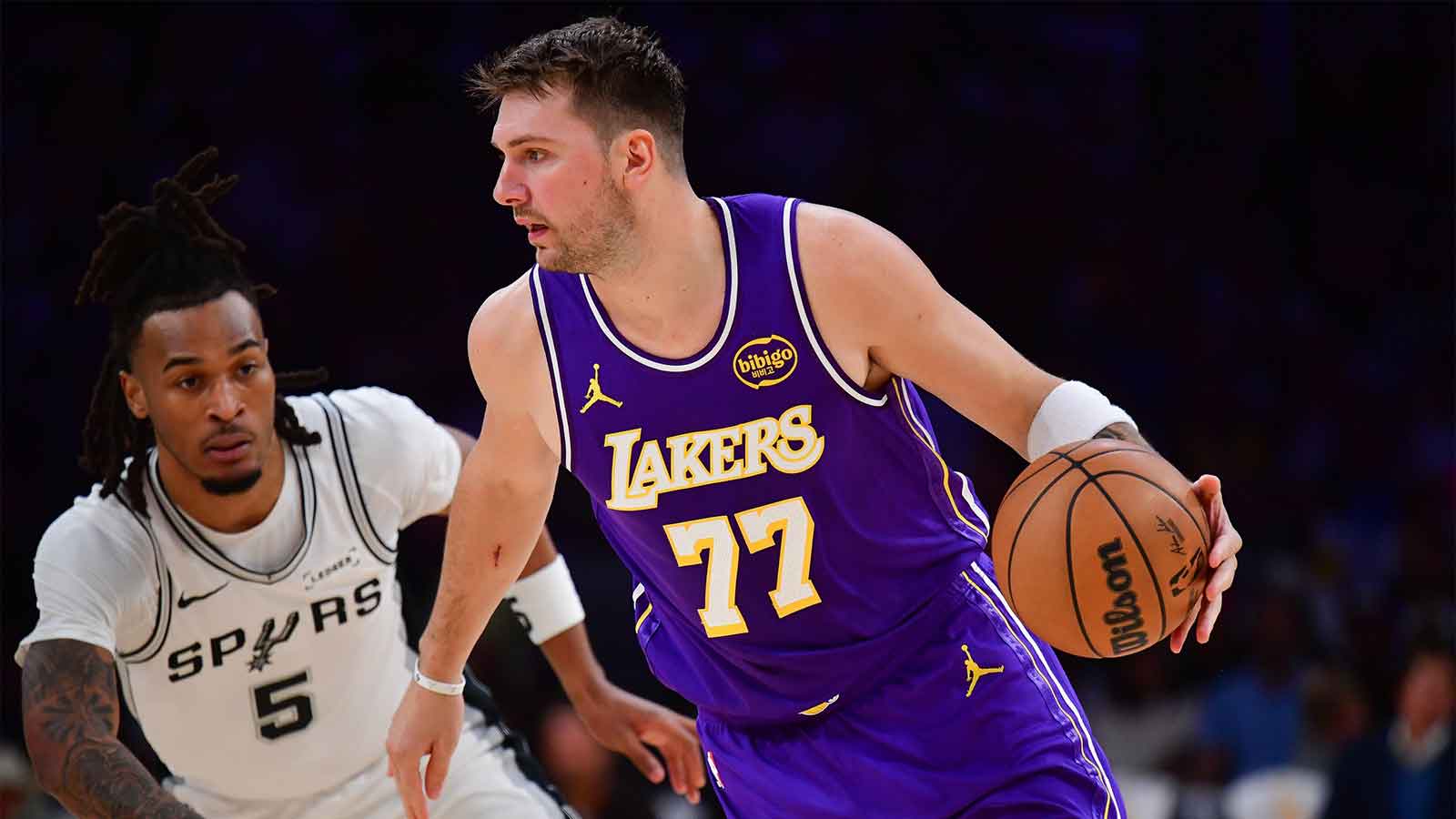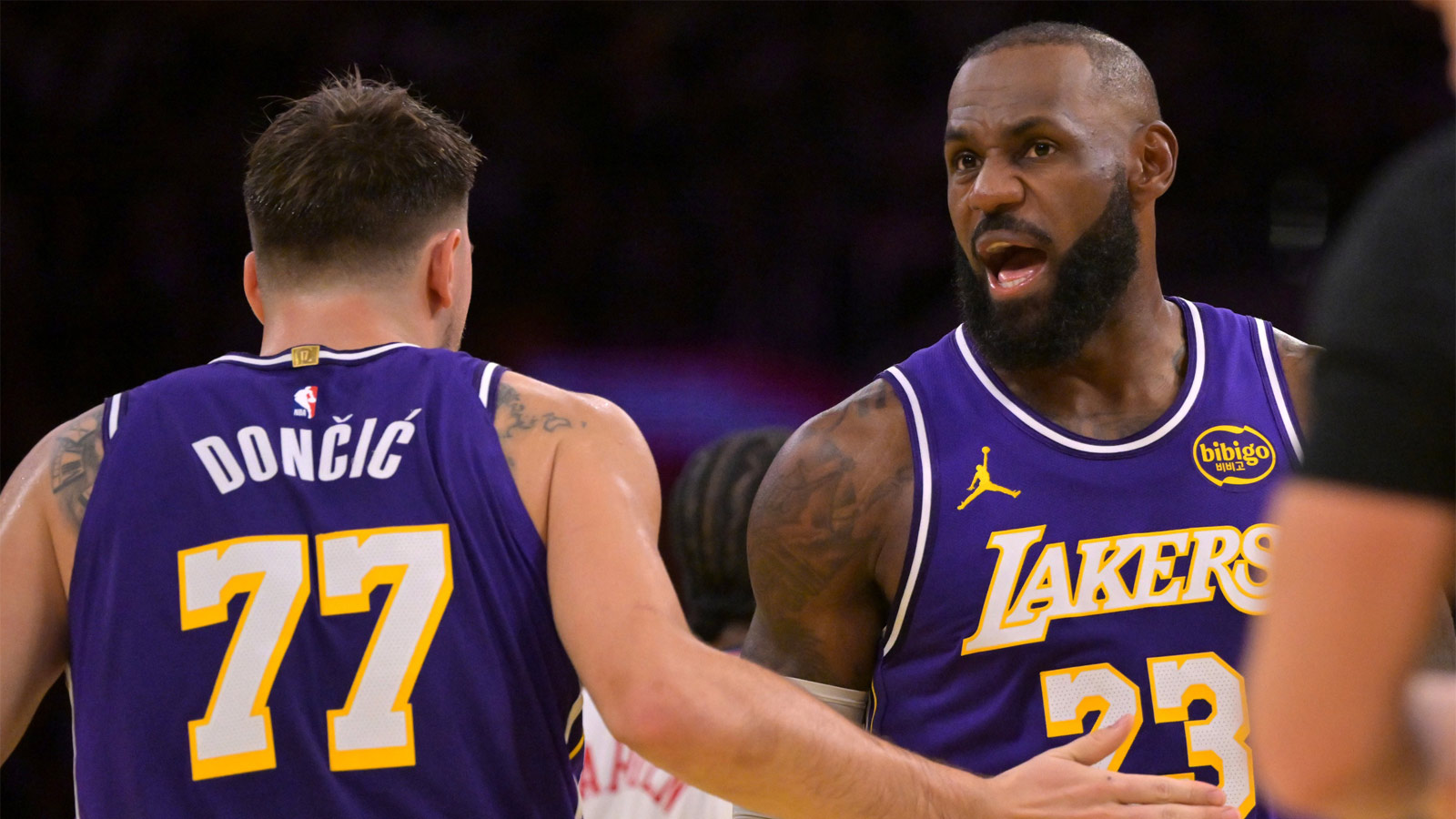- CLUTCH Summary: While in his peak, former Los Angeles Lakers superstar Kobe Byrant was often compared to Chicago Bulls legend Michael Jordan.
- Bryant mimicked much of his game after Jordan's, but the league was becoming different in a post-Jordan world.
- A fun theoretical, while nearly impossible to know for sure, is to wonder how Michael Jordan and Kobe Bryant would do if they switched eras.
Michael Jordan and Kobe Bryant are two of the NBA’s greatest players. The former was drafted in 1984 and the latter in 1996, 12 years apart. Their careers intersected for a few years before Jordan called it quits in 1999 (following the 1998 NBA Finals) but returned to play from 2001 to 2003.
What links these two greats is not only that they were iconic players whom kids and adults continue to look up to for inspiration, but also their style of play. As every basketball junkie knows, Bryant patterned his game after Jordan’s so much that his mannerisms, gestures and interviews look and sound a lot like the man he emulated. What’s interesting about Bryant’s approach to Jordan: Though he owes his game to the Hall of Famer, he would routinely say that he could beat his mentor one-on-one. He’s as competitive as any player who has walked the planet, but isn’t shy about taking cues from someone who has been in the league and conquered it.
Regardless of Bryant’s competitive drive to beat Jordan, the Chicago Bulls' legend embraced the Lakers’ icon like a little brother. The two have had a good mentor-student relationship over the years.
In an interview shared on Twitter by Anthony Slater of The Athletic, Golden State Warriors head coach Steve Kerr revealed his thoughts on the similarities between the players, how they would fare against one another, and how Jordan would have shot more threes if he played in this era:
Steve Kerr on the similarities between Kobe and MJ pic.twitter.com/ld4JiEkVaB
— Anthony Slater (@anthonyVslater) December 18, 2017
“It'd be fun to watch,” Kerr said of a dream one-on-one battle between Jordan and Bryant with both presumably in their prime. “Like I said, very similar games, right? Kobe shot a lot more threes, but in Michael's era threes weren't as big a part of things. I'm sure he would have worked a lot harder on his threes if he played in the modern era. But so similar in terms of the footwork, the reverse pivot, the fadeaways and I'm sure Kobe got a lot of that by watching Michael. Yeah, that would have been fun to watch.”
But what if we were to switch Jordan and Bryant and have them play in the other’s era? That would mean Bryant was drafted by the Lakers in 1984 and Jordan by the Bulls in 1996.
I thought of this idea when someone from the media said that Jordan would average 40 points in today’s game. But instead of just bringing His Airness to the future, why not bring his Heir Apparent to the past at the same time? By doing so, my hope is that we will see the fundamental differences between the two and what makes them unique relative to each other.
Here are a few parameters:
1. Bryant will still end up with the Lakers (whether through a trade with another team or not) on draft night of 1984. Jordan will be taken by the Bulls regardless of his potential draft position in 1996, and regardless of where Chicago will select in our made-up timeline. If we were to simulate the drafting process for a complete fantasy do-over, it would be nearly impossible for the Lakers to draft Bryant in 1984 since he might have been gone by the time it was their turn. Jordan would almost certainly not be drafted third overall in 1996 by the Chicago Bulls.
2. Let’s consider this what-if scenario as a team time warp. This means that we’ll send each player’s entire team forward or backward in time as well. It’s just not feasible to imagine Bryant playing for the Showtime Lakers at a time when they were too loaded already and his impact would be diminished. He could have supplanted Byron Scott as a starter but his stats would not be the same. Placing Jordan in a 1996 team with Scottie Pippen as the elder statesman would significantly affect his impact. We won’t know exactly what the Bulls' lineup would look like without their 1990s championship teams. There are just too many variables to consider if we were to figure out which players the Bulls would have from 1984 to 1996 before Jordan landed in their lap. Besides, without Jordan, Pippen wouldn’t be the player he was, and that’s crucial to the Bulls winning championships.
With these two things in mind, let’s see how Michael Jordan and Kobe Bryant would have fared in each other’s generation!
KOBE BRYANT
Style of Play
No one can deny that Bryant plays like Jordan because he studied the way the Bulls superstar played. In an interview to promote the NBA 2K12 game, Jordan let everyone know that he can beat just about every athletic guard and forward thrown at him one-on-one, except for one he’s not so sure about—Kobe Bryant.
Why?
“Because he steals all my moves,” Jordan said with a cynical smile at the end.
Stealing. Copying. Borrowing. No matter how you view it, Bryant unquestionably took nearly everything that Jordan did on the court, from the moves to the finishes, and made it a part of his weaponry.
So if we were to switch the two, Kobe would have had to learn how to play the game by copying someone else’s work, someone who was also ahead of his time but played the game in the air just as well.
That would be Julius Erving — Doctor J.
What this means for the 18-year old (at the time he was drafted) is he would float more to the basket and finger roll when making a layup. He would also have a different-looking jump shot and his dunks would look vastly unlike Jordan’s. But rather than emulate the older Dr. J, Bryant would likely watch film of — and play like — a younger Erving during his ABA playing days.
For a visual representation of how Kobe might have played in the 1980s, here’s the Doctor during his ABA and NBA career:
https://www.youtube.com/watch?v=SDpXWIpr838
An Erving-like Bryant could have been all the rave in the NBA at a time when the league was on its way to global dominance.
Career
Erving isn’t as efficient as Jordan was, based on his style of play. That would definitely affect Bryant’s ability to score as many points as he did if he had he patterned his play after Dr. J’s game. Another issue with Bryant during this era is injuries. The 1980s and early 1990s were more physical. Though the ultra-competitive guard didn't back down from anyone, he was more prone to injuries than Jordan was. In fact, he played 82 games in a season only four times during his 20-year career. Most of the missed games were due to injuries. If he was hit more than the usual by the more physical teams, he might not have been able to play as many games as he did.
During the '80s, Bryant wouldn’t have shot and made as many 3-pointers as he did, since the three-ball wasn’t a popular weapon of choice back then. It was used mostly as a catch-up tool and a last resort with the shot clock winding down. However, as the three became more utilized in the '90s, Bryant would have taken advantage of the extra point generated by shooting beyond the arc.
Nevertheless, there’s no doubt that Bryant would have been a Hall of Fame player even if he had played from the mid-1980s to the early 2000s.
Judging by his development as a player, Bryant didn’t become a more polished scorer and a challenger for the scoring title until his fifth season. It’s likely that he would have still won the scoring crown at least twice while battling Karl Malone, Charles Barkley, and Patrick Ewing as the league’s leading scorer.
In this era, Bryant’s rivals as a shooting guard would have been Clyde Drexler, Ron Harper, Mitch Richmond, Reggie Miller, Joe Dumars, Hersey Hawkins, Rolando Blackman, and John Starks, to name a few.
More importantly, Bryant and Shaquille O’Neal would have taken over for the Showtime Lakers in this era. Assuming that things play out the same as they did in real life, O’Neal would have left via trade after winning three championships and his young counterpart would have led the Lakers to two more titles later on.
Shoe Deal
Would Bryant have been Nike’s main endorser and thus created a change in the shoe market that would be felt to this day? Could he have had a signature shoe and eventually become Brand Kobe?
That’s tough to say. When Nike wanted to take a risk on a player, it chose someone from the college ranks who was polished enough to have driven sales for its shoes. It’s almost inevitable that Nike would have looked elsewhere to save its struggling company.
This is one of the hardest things to predict because Nike’s rise was very dependent on Jordan’s own growth as a basketball player. His style of play also was one of the most important reasons why he was chosen by Nike executives. With Bryant playing in a fashion which was similar to Dr. J, it’s difficult to visualize how the public would have perceived a player it had seen before, and if that would be enough to captivate crowds in the way Air Jordan did. There’s only a remote possibility that Nike might have signed Bryant to a deal much, much later.
But that’s unlikely.
Since he chose to sign a deal with Adidas from the get-go in 1996, I assume this could be how things played out as well, when he became popular enough a year or two into his career. Remember, signing a player to a shoe deal after the draft was unheard of back then. Bryant’s marketability would have been questionable after coming directly from high school.
Since Kobe would have signed with Adidas, it’s possible he would have made a lengthier deal with the company later on that would have taken him to his prime and his later years in the league. That would have been a mistake, though, since Nike was the more creative of the two. Without Jordan’s shoe deal with Nike as a template for his own, Bryant would have likely forged his own path as an Adidas endorser.
Legacy
Would kids in the 2000s want to be like Kobe in the same way that Jordan spawned a number of kids who flew to the air just as he did?
No doubt.
Can you imagine LeBron James wearing No. 8 or No. 24 instead of 23?
There would be scores of players wearing his Adidas shoes instead of Nikes. They would soar to the air like Dr. J did. The finger roll would be a weapon of choice for the players of the late '90s to 2000s. That “rock the baby” dunk by Erving on Michael Cooper could have been a staple in Kobe’s arsenal, one that dunkers of the 2000 generation would develop into something else.
Players such as Allen Iverson would have included Bryant in his Hall of Fame speech instead of Jordan.
In terms of all-time impact, if Bryant played in the '80s, his status as a Laker legend would have elevated him to even loftier levels, enabling him to be the face of the franchise and the league in that era.
MICHAEL JORDAN
Style of Play
Michael “Air” Jordan was beautiful to watch. He was aesthetically pleasing to the eye but was fundamentally sound. That’s what playing for Dean Smith did for him. He admired Erving and David Thompson, the Skywalker, when he was younger, but he didn’t play exactly like them. If he was drafted in 1996, there’s a chance that Jordan would have watched Kobe and taken notes from his game in the same manner that he was influenced by Dr. J and Thompson… but his style would be all his own.
How Jordan played back in the day is how he would play had he been drafted 12 years later. One of the exceptions might be that he would have shot more threes from the beginning of his career than he did back in the '80s. That would affect his field goal percentage, but his points per game would jump a couple of points higher.
As good a ball-handler as Jordan was, he might actually have been even better in 1996, at a time when the crossover craze started after Iverson made it such a crucial part of his game. This is quite significant because early in his career, Jordan was nearly unstoppable driving to the hole. Give him a more lethal crossover and it’s pretty much impossible to stop him from getting a dunk, layup or a foul.
In comparison to Bryant, Jordan would have undoubtedly been labeled the next Kobe; the shoe would have been on the other’s foot. As a high-flyer, the Bulls' guard would have often found his name in discussions that will challenge him to live up to and surpass his Laker counterpart. But if there is anything that Jordan thrives on, it’s a challenge, no matter how big it is.
Career
What is thought-provoking from this exercise is how Jordan would have played without the hand-checking rule at the prime of his career. During his days with the Bulls, he averaged between 6.9 to 11.9 free throw attempts a game, which could translate to more attempts at the line in the modern era. With the 3-pointer being a weapon of choice rather than an afterthought for Jordan, he would have worked on this part of his game, shot more from long distance, and improved his 3-point percentage.
All these would have added to his nightly points per game average, so those who are saying that MJ would have averaged 40 points in this generation aren’t just making things up.
Despite the physical and bullying tactics that he endured, particularly in the playoffs versus the Bad Boy Detroit Pistons and Patrick Ewing’s Knicks, Jordan played all 82 games in a season nine times out of a possible 15, and in three of those seasons, he played in 78, 80 and 81 games. His 64-game absence in his second season was just a fluke. Considering that Jordan was one of the most durable players ever, had he played with the advancements in treatment, he might not have missed that much at all. Imagine all the additional points he would have at the end of his career with more games played under his belt, more free throws attempted, and more 3-pointers attempted. 36,000 points for his career in 15 seasons wouldn’t be a stretch at all.
The All-Star Game battles between Bryant and Jordan would have been more entertaining with a smaller age gap between them (10 years instead of 14). Neither one of these greats would give an inch! Since Kobe came to the league as a high schooler and had a 20-year career, their head-to-head matchups in the regular season and perhaps even in the Finals would spill over to the middle of the 2000s. We’ll have eight years of Black Mamba vs. Black Cat games to compare these two greats despite one of them being much younger than the other.
Shoe Deal
Here’s where it gets more intriguing. If Kobe had signed with Adidas, and without Jordan in the '80s, Nike might not be that big of a shoe company. More than likely, it would have signed another player to a shoe contract. Depending on which player that was, Nike could have had fairly good sales, but not the shoe giant that it is now. In 1996, Jordan would have been on the radar of a number of shoe companies including Adidas, Reebok, and Converse aside from Nike.
Depending on their pitch, the Oregon-based group could still have landed Jordan to a shoe deal. If it played the cards right, it could still get ahead of its competitors with number 23 as the pitchman. Unleashing the Jumpman in the mid-to-late '90s would have made quite the ripple in the shoe industry, although much later in the shoe game. The big difference this time, however, is that Jordan wouldn’t have been the catalyst he was in the '80s, even though he would have added to its growth.
In a sense, Jordan would be building on Bryant’s foundation at Adidas instead of the other way around. Air Jordan would still have been a shoe line, but he may not have had the Jordan Brand as a subsidiary at Nike. Or maybe he’s such a transcendent player that even with a lesser impact on the shoe culture, Nike would have gone ahead and given him a company of his own. But it’s not as clear-cut as it has been for Jordan in real life.
Legacy
Bringing Jordan’s career to the public’s awareness during the internet and social media revolutions would make him an even bigger global phenomenon with millions of people having access to live Bulls games. It could spawn a bigger fanbase for the University of North Carolina alum and expand his legacy to a wider audience.
As another high-flying two-guard, Jordan will have the shadow of Bryant over his career this time around since by the time Chicago selects him in the 1996 draft, the Lakers star will have been considered the greatest shooting guard in league history, displacing Jerry West even before his career is over. It’s a reversal of roles with Jordan looking to unseat Bryant from his lofty perch.
Rather than comparing apples to apples when it comes to Jordan and Bryant’s games, seeing the latter play differently will be more like comparing apples to oranges. When debating who’s better, we’ll have a clearer distinction between the two because of the contrast in styles.
His shooting guard rivals would be an older Reggie Miller, Jerry Stackhouse, Steve Smith, Allen Iverson, Manu Ginobili, Joe Johnson, Richard Hamilton, Ray Allen, Tracy McGrady, Vince Carter and Dwyane Wade. As you will no doubt notice, most of the best shooting guards of all time played during Bryant’s heyday. Seeing Jordan these great two-guards would have been every fan’s dream come true.
Also, rather than Bryant, Jordan would have been LeBron James’ rival during the latter half of his playing days. Since both would have played in the East, a conference finals matchup between the two would have determined who makes the Finals. Many are debating which of the two is the greatest of all time these days. With their careers overlapping one another, this will be the barometer which will determine who truly gets the upper hand in this conversation among fans and critics alike.
Conclusion
What’s healthy about this exercise is, as discussed in greater detail above, Bryant would have separated himself from the stigma of being compared to Jordan because of his playing style. We’d have an easier time comparing the two and determining who’s better since they would be vastly different players stylistically. Critics would have viewed Bryant more fairly since he wouldn’t have mirrored Jordan but would have been judged on his own merits. As good as Dr. J was, I think it’s fair to say that Bryant would have surpassed him as a player more easily than playing in a similar fashion to Jordan and supplanting His Airness as the better player.
A Dr. J-like Bryant versus Michael Jordan would have been a more compelling comparison.
Without Jordan as the template, it doesn’t mean Bryant wouldn’t have been as good a player. The drive to excel and the ability to succeed would remain. Switching eras for Bryant just means he would have separated himself from Jordan and created a useful distinction for us to evaluate both players better.
As it currently stands, Jordan cast such a huge shadow over Bryant that it’s difficult for Kobe to penetrate the G.O.A.T. conversation as a result of his playing style being similar to Jordan’s. If their careers had played out in this “what if” scenario, it would have benefited Kobe’s legacy more, especially since he would have been the precursor to Jordan rather than the other way around.
One thing is for sure, though: Both would have been great players no matter which era they played in. Jordan in 1996 and Bryant in 1984 will only live on in our dreams. Like most dreams, this dream may be better than reality.


